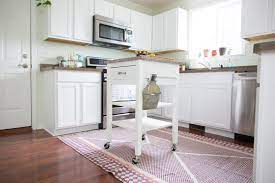Kitchen rugs can be a great addition to any kitchen, adding both warmth and style to the space. However, they can also attract dirt, food spills, and stains, making them difficult to clean. In this guide, I will explain the steps you need to take to clean kitchen rugs effectively.
Tools and materials you will need:
Vacuum cleaner
Baking soda
Vinegar
Dish soap
Scrub brush
Bucket
Hose or showerhead
Towels or rags
Step 1: Remove loose dirt and debris
Before you start cleaning your kitchen rug, you need to remove any loose dirt and debris from the surface. To do this, use a vacuum cleaner to suction up any crumbs, dust, or hair. If the rug is too large to move, use the hose attachment to vacuum around the edges and corners. This step will make the cleaning process more effective and prevent dirt from being ground deeper into the fibers.
Step 2: Shake out the rug
Once you have removed any loose dirt and debris, take the rug outside and shake it vigorously to dislodge any remaining dirt or dust. Hang the rug on a clothesline or fence and beat it with a broomstick to remove any embedded dirt. If you don’t have access to an outdoor space, you can hang the rug over a railing or fence inside the house.
Step 3: Apply baking soda
Baking soda is a great natural cleaner that can help remove odors and stains from kitchen rugs. To use baking soda, sprinkle a generous amount over the surface of the rug and let it sit for at least 15 minutes. This will allow the baking soda to penetrate the fibers and absorb any odors or stains. For especially dirty or smelly rugs, you can leave the baking soda on for up to an hour.
Step 4: Vacuum up the baking soda
After the baking soda has had time to work its magic, use a vacuum cleaner to suction up the powder. Be sure to vacuum in all directions to remove as much of the baking soda as possible. If the rug still smells or looks dirty, repeat the process with more baking soda.
Step 5: Spot-clean any stains
If your kitchen rug has any stubborn stains, you will need to spot-clean them before washing the entire rug. To do this, mix a solution of equal parts vinegar and water and add a small amount of dish soap. Dip a scrub brush into the solution and gently scrub the stain in a circular motion. Be careful not to scrub too hard, as this can damage the fibers. Once you have removed the stain, rinse the area with water and blot it dry with a towel or rag.
Step 6: Wash the rug
After spot-cleaning any stains, you can wash the entire kitchen rug. To do this, fill a bucket with warm water and add a small amount of dish soap. Dip a scrub brush into the solution and gently scrub the rug in a circular motion. Be sure to scrub all areas of the rug, including the edges and corners. Once you have scrubbed the entire rug, rinse it thoroughly with a hose or showerhead. If you don’t have access to an outdoor hose, you can rinse the rug in a bathtub or shower.
Step 7: Hang the rug to dry
After washing the rug, hang it up to dry in a well-ventilated area. You can use a clothesline, a fence, or a drying rack to hang the rug. Be sure to hang the rug evenly and avoid folding or creasing it, as this can damage the fibers. Allow the rug to dry completely before putting it back in place in your kitchen.
In conclusion, cleaning kitchen rugs can be a simple and effective process if you follow these steps. By removing loose dirt and debris, applying baking soda, spot-cleaning any stains, washing the rug, and hanging it up to dry, you can keep your kitchen rugs looking clean and fresh for years to come. Remember to always test any cleaning solution on a small, inconspicuous area of the rug before applying it to the entire surface. This will help you avoid any damage or discoloration to the fibers. By regularly cleaning your kitchen rugs, you can not only maintain their appearance but also extend their lifespan and keep your kitchen a clean and healthy environment for cooking and eating.

